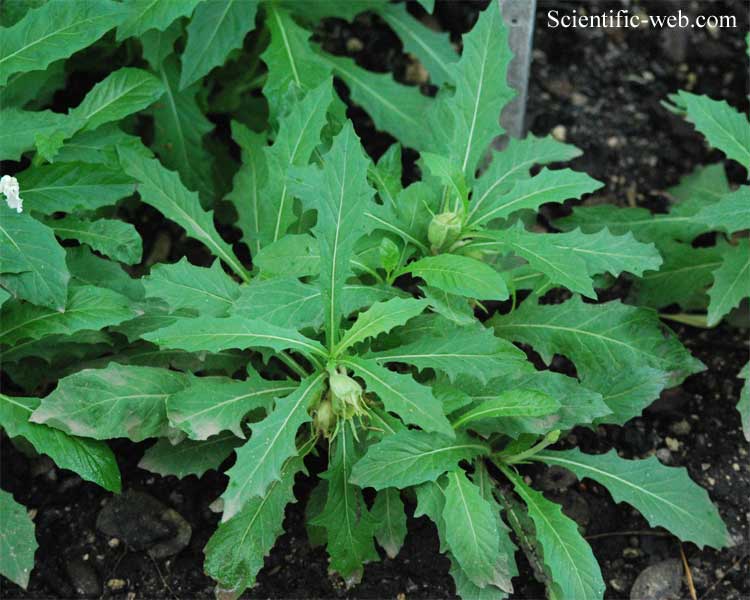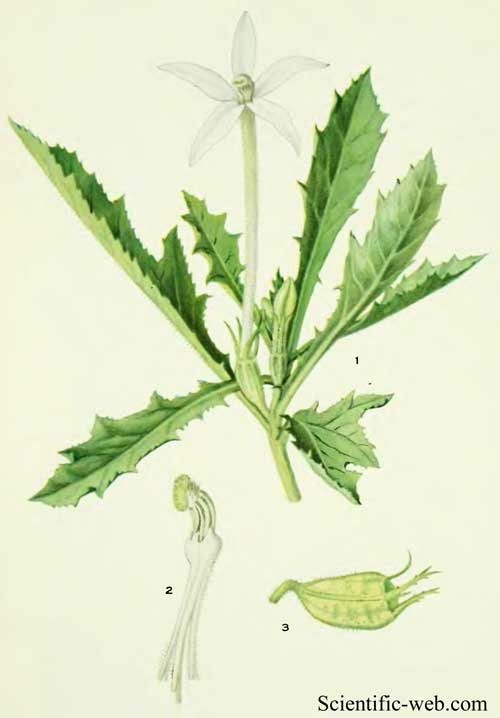
Hippobroma longiflora, Photo: Michael Lahanas
Classification System: APG IV
Superregnum: Eukaryota
Regnum: Plantae
Cladus: Angiosperms
Cladus: Eudicots
Cladus: Core eudicots
Cladus: Asterids
Cladus: Campanulids
Ordo: Asterales
Familia: Campanulaceae
Subfamilia: Lobelioideae
Genus: Hippobroma
Species: Hippobroma longiflora
Name
Hippobroma longiflora (L.) G.Don, Gen. Hist. 3: 717 (1834).
Synonyms
Basionym
Lobelia longiflora L., Sp. Pl.: 930 (1753).
Homotypic
Rapuntium longiflorum (L.) Mill., Gard. Dict. ed. 8: n.º 7 (1768).
Isotoma longiflora (L.) C.Presl, Prodr. Monogr. Lobel.: 42 (1836).
Laurentia longiflora (L.) Peterm., Pflanzenreich: 444 (1845).
Solenopsis longiflora (L.) M.R.Almeida, Fl. Maharashtra 3A: 155 (2001).
Heterotypic
Isotoma runcinata Hassk., Bonplandia (Hannover) 7: 181 (1859).
Laurentia longiflora var. runcinata (Hassk.) E.Wimm., Ann. Naturhist. Mus. Wien 56: 337 (1948).
Isotoma longiflora var. runcinata (Hassk.) Panigrahi, P.Daniel & M.V.Viswan., Indian J. Forest. 4: 151 (1981).
Distribution
Native distribution areas:
Continental: Northern America
Regional:Caribbean
Jamaica
References: Brummitt, R.K. 2001. TDWG – World Geographical Scheme for Recording Plant Distributions, 2nd Edition
References
Don, G. 1834. A general history of the dichlamydeous plants, comprising complete descriptions of the different orders; ...; the whole arranged according to the natural system. Vol. III. — Calyciiflorae. VIII+867 pp. J.G. and F. Rivington, et al., London. BHL Reference page.
Links
Govaerts, R. et al. 2019. Hippobroma longiflora in World Checklist of Selected Plant Families. The Board of Trustees of the Royal Botanic Gardens, Kew. Published on the internet. Accessed: 2019 Aug. 02. Reference page.
International Plant Names Index. 2019. Hippobroma longiflora. Published online. Accessed: Aug. 02 2019.
Tropicos.org 2019. Hippobroma longiflora. Missouri Botanical Garden. Published on the internet. Accessed: 2019 Aug. 02.
USDA, ARS, Germplasm Resources Information Network. Hippobroma longiflora in the Germplasm Resources Information Network (GRIN), U.S. Department of Agriculture Agricultural Research Service. Accessed: 09-Oct-10.
Vernacular names
English: Star of Bethlehem
español: Revienta caballos, ciega ojo
français: Étoile de Bethléem

Hippobroma longiflora
Hippobroma longiflora, also called Star of Bethlehem or madamfate,[1] is a flowering plant in the family Campanulaceae. It is the only species in the genus Hippobroma. It is endemic to the West Indies, but has become naturalized across the American tropics and Oceania.[2]
It is notable for its concentrations of two pyridine alkaloids: lobeline and nicotine. The effects of nicotine and lobeline are quite similar, with psychoactive effects at small dosages and with unpleasant effects including vomiting, muscle paralysis, and trembling at higher dosages.[3] For this reason, H. longiflora (and its various synonyms) is often referenced for both its toxicity and its ethnobotanical uses.
When uprooting this weed, it is important to wear gloves: the sap is an irritant which can be absorbed through the skin, and a small amount of sap in the eyes can cause blindness.
References
USDA, NRCS (n.d.). "Hippobroma longiflora". The PLANTS Database (plants.usda.gov). Greensboro, North Carolina: National Plant Data Team. Retrieved 15 May 2015.
"Hippobroma". Germplasm Resources Information Network (GRIN). Agricultural Research Service (ARS), United States Department of Agriculture (USDA). Retrieved 7 December 2007.
Baldwin, Roger E. (1979) [1979]. Hawaii's Poisonous Plants (1 ed.). Hilo, Hawaii: The Petroglyph Press, Ltd. pp. 26–27. ISBN 978-0-912180-34-2.
Retrieved from "http://en.wikipedia.org/"
All text is available under the terms of the GNU Free Documentation License

